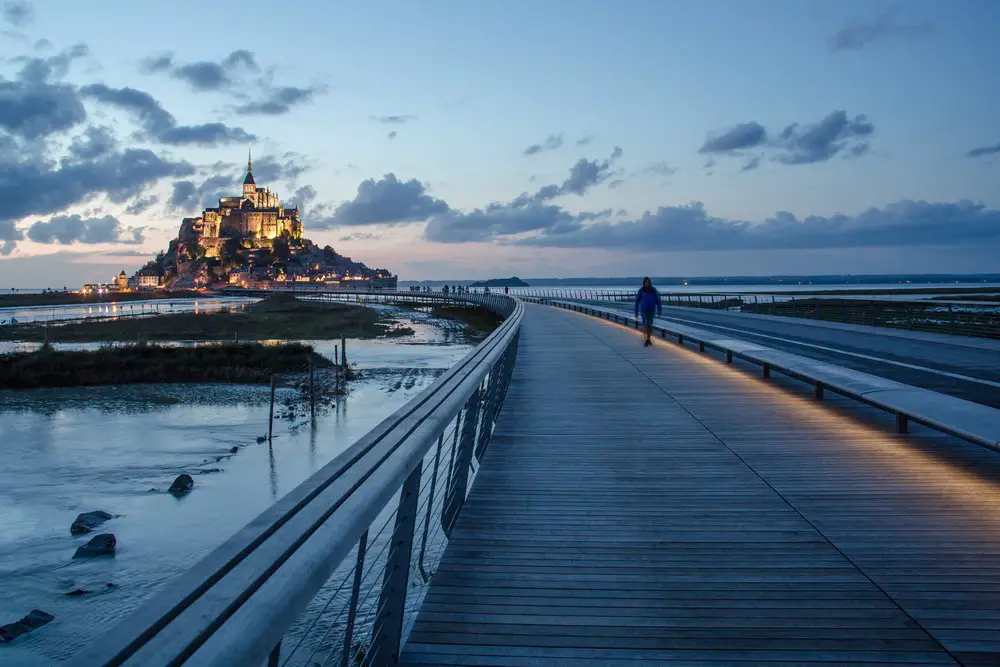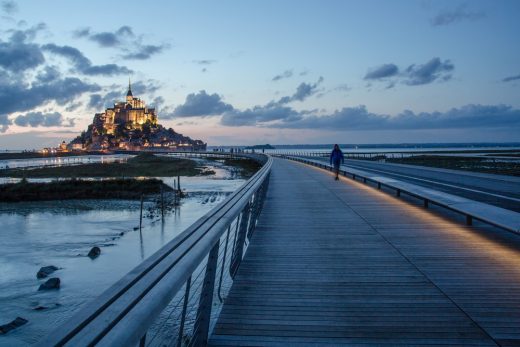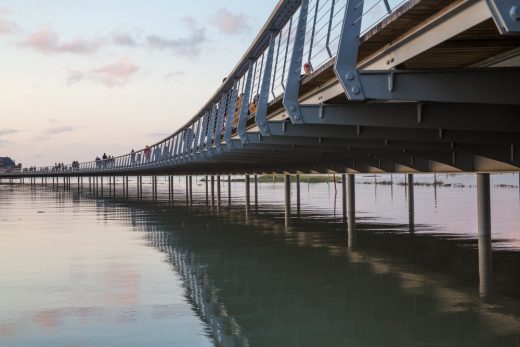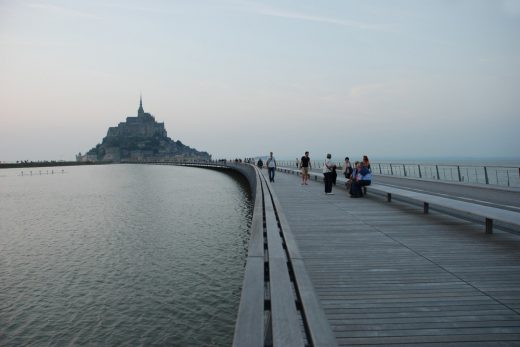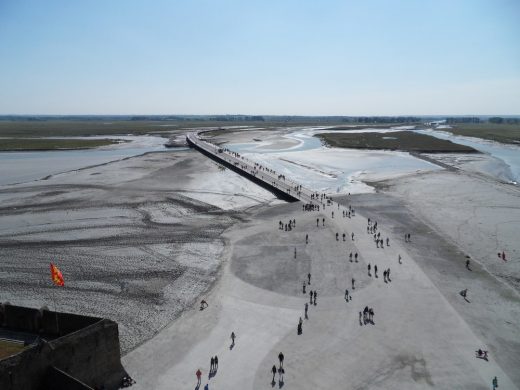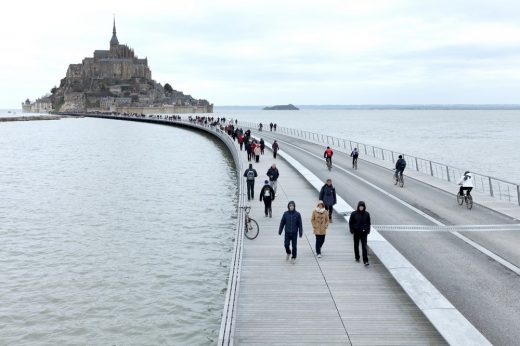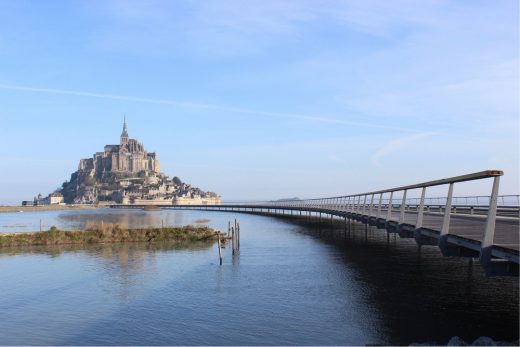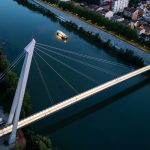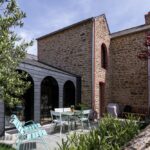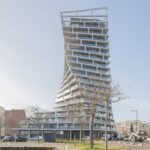The Jetty to the Mont-Saint-Michel, France, Architect, Images, Architecture
The Jetty to the Mont-Saint-Michel
French Causeway : Bridge & footbridge – design by Dietmar Feichtinger Architectes
4 May 2016
The Jetty
Design: Dietmar Feichtinger Architectes
Location: north west France
The Jetty to the Mont-Saint-Michel
‘Walking on water’ by Dietmar Feichtinger, July 2014
Creating a new access to one of the most remarkable cultural monuments and landscapes in Europe is a rare challenge for the design of a causeway.
The estuary of the Couesnon River surprises by the immensity of the bay surrounding the Mont Saint-Michel, by the beauty of light and the colours of the natural elements. The changing sea level by tides rising up to 14 m, creates a repeated event exposing the forces of nature and offers a variety of landscapes alternating between land reaching far out into the sea on low tide and the water filled bay with the Mont transformed into an island as only landmark on high tide. This radical change contributes to the magic of the site.
The minimal slope of the estuary and one of the world’s highest differences between tides accentuate the phenomenon: the sea is approaching the coast like galloping horses according to Victor Hugo.
The natural site contrasted by man’s impact
Built on a rock in the bay, the medieval town of Mont Saint Michel topped by its abbey and monastery represents a major cultural landmark on one of the most visited sites in France. The Mont-Saint-Michel and its bay are part of the Unesco list of World Heritage Sites since 1979.
In 1897 a dam exceeding the highest level of high tide was built to connect the land to the Mont Saint Michel Island to assure permanent safe access for visitors. By obstructing the Couesnon River partially sand was accumulating approaching the continent to the island.
In order to preserve the island a new causeway and a 756 meters long jetty replace the existing road allowing water to circulate and to restore the insularity of the Mont-Saint-Michel.
The new causeway and jetty, a delicate answer
In this sensitive context human intervention is delicate. The new causeway and jetty with a total length of two kilometres search for continuity and perfect integration into the site.
The jetty’s design blends into the landscape by achieving a maximum of transparency. Perfectly horizontal, the deck merges into the horizon contrasting the verticality of the abbey. Its slenderness is achieved by a sequence of 134 pillars with only 24,4 cm of diameter and a distance of 12metres between each pair. Obstruction to water is minimized. The pillars are fixed on the bottom into the foundation –concrete pillars with a diameter of 120cm founded on rock about 30 meters under sea level – and on top to the deck avoiding any diagonal structural element to achieve its pure appearance.
Walking on water
From the mainland to the Mont, the general geometry forms a continuous curve. Slightly offset to the East before turning back, it offers a variety of views. The jetty becomes part of the bay following the smooth lines designed by water.
The new causeway and jetty assure a safe walkway for visitors as well as a central roadway for shuttle services.
Bi-directional shuttle busses assure the connection of the new parking on the continent to the Island using the central part with a width of 6m50. It grows constantly up to a width of 8m50 at the terminal which is situated in a distance of 300 meters to the entrance in the defense wall of the Mont.
Walkways for pedestrians run along the road on either side with varying widths according to the expected crowd of pedestrians: a main connection 4m50 wide on the west side – 5m50 on the terminal, a secondary walkway 1m50 wide on the east – 2m50 on the terminal.
The central road carries the walkways on cantilevers, large balconies offering fantastic perspectives. The columns are situated under the central part. The shadow of the balcony enforces their discrete appearance.
During high tide sea level is just under the level of the deck giving the impression of walking on water.
The last two hundred meters of the jetty are descending by 1% leading to a concrete platform facing the Mont. The platform is submerged several days a year on high tide and provides total insularity of the Mont Saint-Michel.
Rough untreated materiality
A transversal steel structure carries the concrete deck in the center. On each side of the roadway, cantilevers – T-formed steel consoles – support a wooden deck.
Few materials are applied harmonizing with the colours of the bay. Whenever possible they are applied untreated. The modification of the aspect with time and weather conditions corresponds to the roughness of the medieval constructions.
The main structure in steel is coated with a metallic light grey finishing on the anti-corrosion complex. All connections of the main steel structure are welded allowing a clear legibility of forces.
The central part supports a concrete slab accessible for vehicles up to 38 tons, with asphalt coating hydro treated and polished.
The deck of the walkways on the sides is in oak wood without treatment. The wood cladding is factory pre mounted forming panels with stainless steel fixation underneath.
The curved handrail is also in oak wood composed by three elements and mounted on steel posts. Horizontal pre stressed stainless steel cables provide the filling of the railing.
Separation elements are installed between the road and the main walkway on the west made of untreated fibre concrete mounted on steel posts. Like a continuous bench they offer seating to rest and contemplate the site.
Discrete lighting
Light is discrete. It guides the visitors and underlines the walk path. The splendour of the lit up monument contrasts with the spare light on the access paths.
LED light bars are fixed underneath the separation element and underline the horizontality with indirect light.
Guiding lights are integrated in the wooden panels on the small east part and on the causeway.
All supplies – water, electricity, telecommunication – for the village situated on the island are integrated in the access road. They are situated under the concrete slab. Exposed to walkers in the bay the tubes are part of the design and carefully integrated.
The formal simplicity allows perfect integration. It hides the complexity of a sophisticated technical approach.
The coherence of the architectural and technical approach reflects the ambition to magnify this beautiful site.
Main features
The jetty is 756m long. It is subdivided in seven sections. The first and final sections are 78m long. Sections 2 to 6 are 120m long.
The standard width of the jetty is 12m50. It is composed into a pedestrian part on the west side with a width of 4m50, two carriage lanes 6m50 wide and a 1m50 walkway for pedestrians on the east. The section rises up to 17m50 (6m50 + 8m50 + 2m50) at the Terminal of the shuttles which is situated 300 meters away from the defense wall of the Mont. The section diminishes towards the Mont and is 10m50 large (4m50+4m+1m50) at the connection with the arriving platform facing the Mont.
The jetty is founded on 67 pairs of concrete pillars 120cm of diameter and 4 more pillars for the abutments. The length of the founding pillars is approximately 30m. The steel piles of the jetty are fixed on top of the pillars about 2m under the estimated ground level after removing the accumulated sand.
Bentonit is used to create the reservation for the pillars. A cage of armature is placed; the piles are precisely adjusted and anchored with concrete.
The pairs of steel piles placed in a distance of 12m longitudinally are 25cm of diameter with a thickness of 40 to 60mm depending on their location. They are also fixed on top to the steel structure of the deck by a welded connection.
The deck is composed of a central part and two side parts as cantilevers. Two longitudinal beams, welded steel boxes are fixed on the top of the piles.
They are connected transversally by crossbeam in I section all 3m. A concrete slab is fixed on the beams for the road part. The top layer consists of a layer of treated asphalt (high pressured water and polishing). The consoles carrying the side parts are welded on to the longitudinal beams. Longitudinal T-profiles carry the oak planking (50mm of thickness).
Expansion joints are provided all 120m.
A continuous bench made of high resistant concrete and carried on double steel plates separates the road from the pedestrian part. LED lamps are integrated under the bench to light up the pedestrian part on the west side. The pedestrian part on the east is lit by floor integrated spots in LED.
The railings are made of steel posts fixed on the consoles carrying a wooden handrail (oak). 9 horizontally stressed stainless steel cables compose the filling.
The jetty is the only access road to the Mont Saint Michel. It carries trucks up to 40 tons.
1800 t of steel, 1400 m3 of concrete for the central part with 2 lanes and approximately 4500 m3 of concrete for the foundations. The earthwork for the new dam adds another 45 000 m3.
Anti-corrosive protection for the steel structure is obtained by a coating type C5M for sea environment. The complex is reinforced on the end part towards the Mont where the structure is flooded regularly. The piles standing permanently in the water are treated with a special IM2 coating. Specific elements are additionally galvanized (railing, tubes for conducts).
The building costs are about 31 M € net, 37 M € including VAT.
The Jetty to the Mont-Saint-Michel – Building Information
Architect: Dietmar Feichtinger Architectes, mandatory
Competition Team: Christian Schmölz, Gabriel Augier, Rupert Siller, Ulrike Plos, Barbara Feichtinger-Felber, Michael Felder, Wolfgang Juen, Frank Hinterleithner
Renderings: Images de synthèse,
Images: Paul-Eric Schirr-Bonnans, José-Luis Fuentes
Text: Armelle Lavalou
Project Team: José Luis Fuentes, Christian Wittmeir, Guy Deshayes, Mathias Neveling, Arne Speiser
Engineer: Schlaich Bergermann und Partner
Client: Syndicat Mixte Baie du Mont Saint-Michel
Location: Manche (50), Normandie, France
The Jetty to the Mont-Saint-Michel images / information from Dietmar Feichtinger Architectes
Dietmar Feichtinger Architectes
Location:Le Mont-Saint-Michel, France
New Buildings in France
French Architectural Projects
French Architect Offices – design firm listings
Community Centres
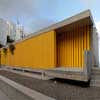
photo : Jorge Hernandez
Northwest French Architecture – Selection
Stanton Williams Architects

picture from architect
Grand Musée d’Art Nantes : international design competition
Nantes Tripode
Atelier d’architecture Christian de Portzamparc
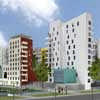
image from architect
Nantes Tripode
French Architecture – Selection
Zenith Music Hall Strasbourg
Massimiliano Fuksas Architecture
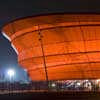
photo : Moreno Maggi
Zaha Hadid Architects
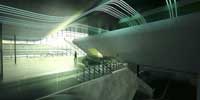
picture from architects
Comments / photos for the The Jetty to the Mont-Saint-Michel page welcome
The Jetty to the Mont-Saint-Michel
Website: Dietmar Feichtinger Architectes

